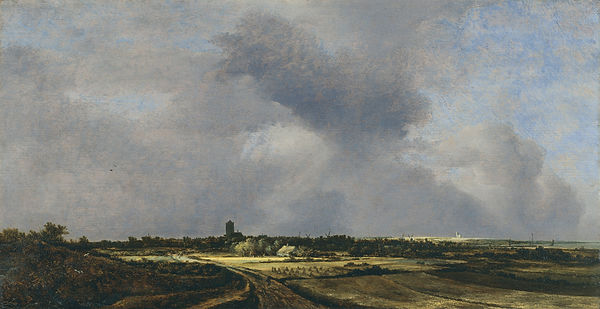<A>
Renaissance perspective (linear)
LEFT--Niccolò Mauruzi da Tolentino unseats Bernardino della Ciarda at the Battle of San Romano, Uccello, (1435-55), tempera on wood, Florence
RIGHT--
Finding and Proving of the True Cross, Piero della Francesca (1452-55), Arezzo, San Francesco St. Helena is shown twice. At the left she directs the removal of the Cross from the ground in which it was buried. On the right she kneels in adoration as the Cross is proved to be the True Cross-by raising a dead boy to life.


From 1450 onwards, time linear perspective was understood and regularly employed, such as by Perugino in his Christ Giving the Keys to St. Peter (1481-82) in the Sistine Chapel.

Baroque perspective (aerial or atmospheric)
LEFT--Quadratura is illustrated in the Triumph of the Name of Jesus, 17th-century fresco painting by Giovanni Battista Gaulli; the fresco occupies the nave of the Il Gesu, with both fresco painting and stucco molding.
RIGHT-- View of Delft, oil painting by Vermeer (166061); it is of the Dutch artist's hometown & is among his most popular, painted when cityscapes were uncommon.

<B>
Leonardo (intense depth effect): *
The Virgin and Child with Saint Anne (1503-19); the monumental 3D quality of the group and the calculated effects of dynamism and tension in the composition made it a model that inspired both Classicists & Mannerists.


<C>
Guercino, (intense depth effect): *
Moonlit Landscape (1616), oil on canvas, an early, naturalistic landscape.

<D>
Albani (intense depth effect): *
The Baptism of Christ (1640), oil on canvas
.jpg)
<E>
Ruysdael (intense depth effect): *
View of Naarden with the Church at Muiderberg in the Distance (1647)

<F>
Hobbema (intense depth effect) *
Forest landscape with a merry company in a cart, 1665.

<G>
Watteau (intense depth effect): *
The Embarkation for Cythera, 1717; it depicts a departure from the island of Cythera, the birthplace of Venus, symbolizing the temporary nature of human happiness; his light and wispy brushstrokes, & the hazy landscape in the background give no clues about the season, or whether it is dawn or dusk.

<H>
Corot (intense depth effect):
Ville d’Avray, 1865, oil painting; the painting is of the commune where Corot lived in Ville d'Avray.

<I>
phallus-symbol (red): *
Mural of Priapus depicted with the attributes of Mercury in a fresco found in Pompeii

<J>
Madonna's mantle (pure blue): *
The Virgin in prayer, Sassoferrato (1654); a particularly vivid example of Marian blue comes from the Italian Baroque painter Sassoferrato, whose The Virgin in Prayer is draped in rich, sumptuous colour—rose pink, deep blue, and folds of creamy white.

<K>
Griinewald (dusky green): *
The Small Crucifixion, 1511-20, oil on panel, done for Wilhelm V, duke of Bavaria
